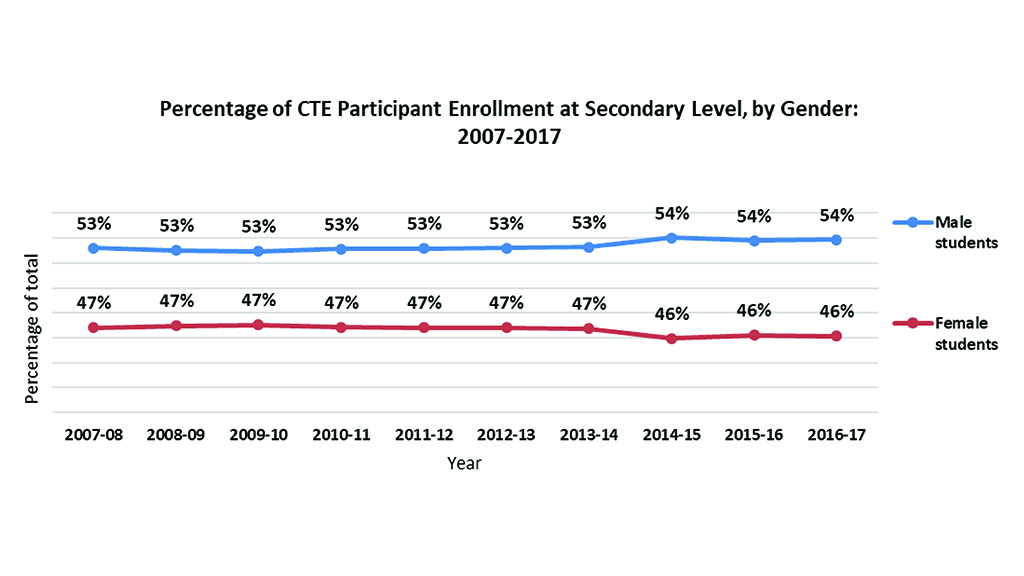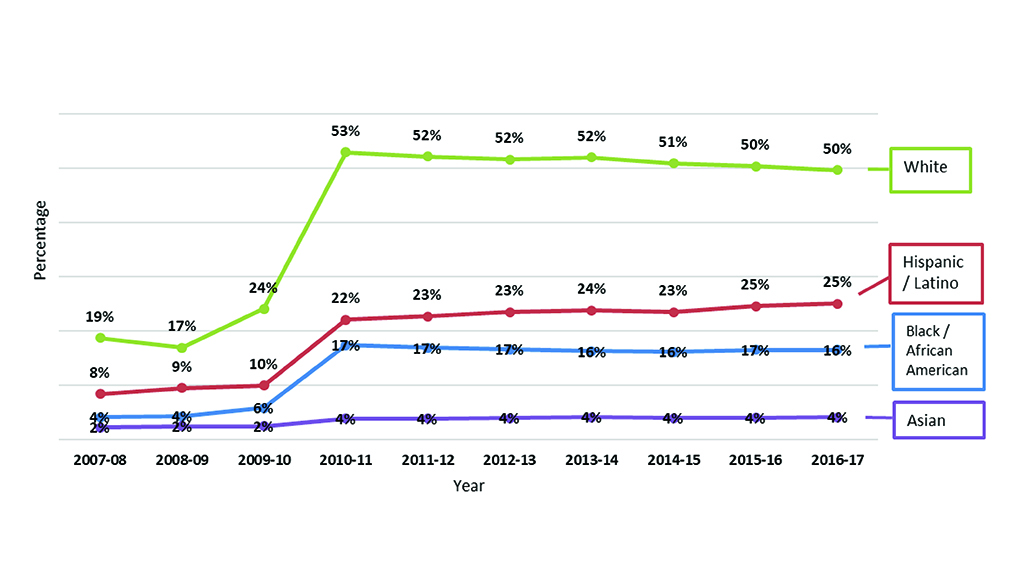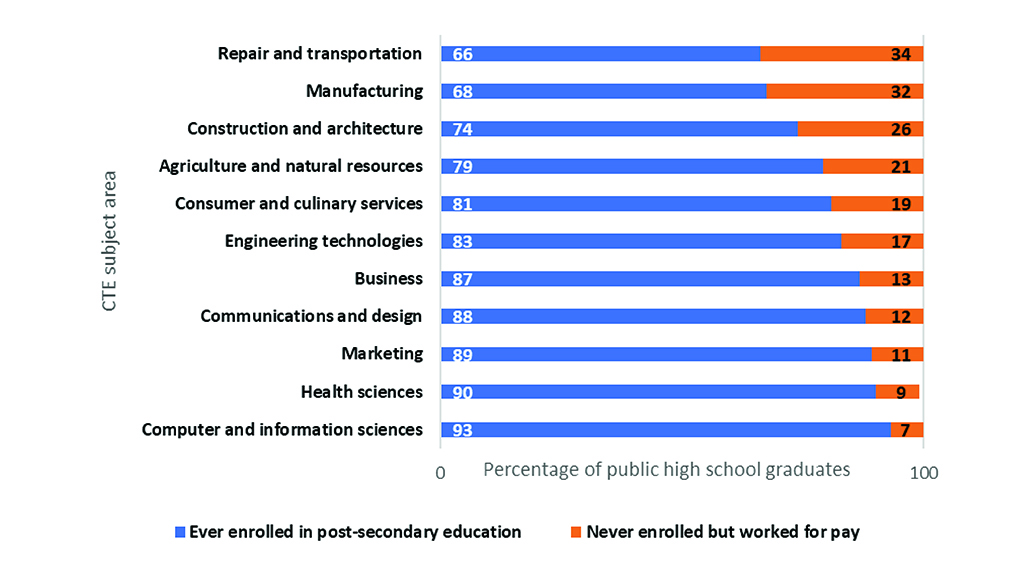Our nation faces a shortage of people prepared for critical high-skill and high-wage jobs who hold an advanced credential, an associate degree, a bachelor’s degree, or higher. The “college for all” movement has led many students to express an interest in attending a four-year college. But they didn’t necessarily attend college because they want to earn a specific degree required for a specific career. Rather, they lacked exposure to or understanding of other career paths that lead to an advanced credential and good jobs aligned with their interests and skills.
While the numbers of high school graduates heading off to college has increased in recent years, the percentages graduating with a four-year degree have not increased proportionally.
Our challenge is not simply that we have too few people with a bachelor’s or master’s degree. We have major gaps in critical career fields that could be filled by employees with an associate degree or advanced career credential. Too many students have degrees that are unlikely to lead to a high-demand job.
Graduation rates and graduate salaries by majors are not widely advertised by postsecondary institutions, and little is done to educate students, parents, high school leaders, teachers, and counselors about the level of academic readiness needed to pursue an advanced career credential, according to economists at the Georgetown University Center on Education and the Workforce.
A failure to prepare high school graduates will hamper many young people for the rest of their lives and hurt their chances of attaining good jobs. Today, a high percentage of recent graduates and a growing number of older adults, particularly men and persons of color, are chronically unemployed or underemployed because they lack the preparation necessary to obtain a good job.
High School, Middle School Goals
The numbers paint an alarming picture, but schools have what it takes to set and meet the bold goals that can overcome these challenges. We must begin by convincing parents, students, and the public that we can no longer settle for the status quo. We must increase the percentage of students completing high school and graduating with the foundational skills needed to access good jobs and advance study.
Rapidly improving students’ preparation for college and careers will require setting higher expectations for students and then relentlessly providing the unconditional support necessary for each student to meet those higher standards and to graduate from high school truly equipped for post-graduation success.
Teachers need support to design assignments that engage all students in critical thinking and deeper learning, always moving toward credentials — whether they are university, technical, or career-based — that matter.
Setting bold goals involves assisting school leaders and teachers to understand how to embrace the innovative school and classroom practices that prepare more students to graduate ready for postsecondary studies, careers, or both.
Proportions of CTE participants in the student subpopulations

Bold goals for high schools:
- At least 95 percent of students who enter grade nine graduate from high school (the goal of many European countries).
- At least 90 percent graduate college-ready, career-ready, or both, having mastered those power standards in literacy and mathematics so critical to future success.
- At least 80 percent of students earn a credential or degree of value by age 25.
Bold goals for middle schools:
- Students enter ninth grade ready to succeed in college-preparatory academic courses and in challenging career pathway courses.
- Students enter ninth grade with the demonstrated literacy skills needed to read, analyze, and comprehend a range of grade-level texts and materials in all subject areas.
- Students enter ninth grade having successfully completed algebra I to a validated performance level or having demonstrate readiness for algebra I.
Setting these goals is a first step to increase the percentage of students acquiring advance credentials or degrees that can lead to middle-class income or higher.
These goals cannot be achieved by acting in isolation. School leaders, business leaders, community members, and parents must be invested. They must understand the consequences of failing to set bold goals and then act strategically, and with intensity, to achieve them. Only such an effort can energize local leaders to create the conditions and support for achieving bold goals.
Percentage of CTE participants by race/ethnicity: 2007-2017

How to Do It
The following are recommendations for how school leaders can work to achieve these goals.
Base local accountability systems on the principle of valuing both college and career readiness equally.
School districts must take ownership for creating a sufficiently rigorous accountability system, with readiness benchmarks that will prepare graduates to meet the bold goals of college readiness, career readiness or both.
To create the conditions for an effective local accountability system, schools and community leaders must examine how they value college and career readiness, and how to take student engagement and rigor to the next level. Do connections between middle and high school support critical pathways toward post-graduation success in college, careers, or both? Do local definitions of readiness place enough weight on career readiness?
Undervaluing the “career readiness” component of “college and career readiness” hampers our ability to envision and implement career pathway programs of study that motivate students and lead to both good jobs and postsecondary studies.
Set accountability standards higher than those set by the state.
Accountability systems should build on and expand your state’s framework, using additional indicators for assessing readiness.
Over years of research, Southern Regional Education Board’s (SREB) High Schools That Work program found that higher-performing school districts and schools set targets that exceeded state expectations; and these higher expectations resulted in changes in how students were taught, what they were taught, and the type of assessments that were given to students.
Do not undervalue students by holding them to lower readiness standards.
We undervalue students when we fail to set rigorous readiness indicators for college and careers. School and district leaders must show that they value students by making the changes necessary to move away from a system that allows more than half of students to leave high school without the literacy and mathematical knowledge and skills needed to succeed in college and careers.
Recognize the middle grades’ role.
The connection between the middle grades and high school is a critical piece of any district’s ability to meet bold goals. We should be preparing students in grades six through eight for a rigorous high school curriculum that leads to most students completing high school ready for some level of postsecondary education. This will require an intensive effort to align the middle grades curriculum to high school readiness standards for literacy, mathematics, and science and to create rigorous pathways toward success.
Work with postsecondary institutions and employers to bring a new depth to curriculum and course design.
In establishing accountability systems to achieve bold goals, school systems should work with two- and four-year colleges and employers to define true academic readiness for students’ next steps. School districts can work with postsecondary partners using state and other assessments and indicators to determine literacy and mathematics performance levels and school experiences that would indicate academic readiness for college and for careers.
Hold teachers accountable for keeping students on track for college and career readiness.
Teachers need to learn new methods and approaches, and some students need extra time and support — and both teachers and students need to know that the school community is committed to giving them the support necessary to meet standards.
Paths CTE students take after graduating from high school

Measuring Progress
How will we know these actions are having the desired effects? It is through an effective accountability system that we learn whether proven practices in school and classrooms have been implemented with fidelity and whether these are advancing students’ readiness for future success.
Achieving bold goals requires not only agreeing upon the desired level of achievement, but also frequently measuring progress toward those desired outcomes. And the success of such measurements depends on a well-developed local accountability system.
The accountability system should drive instruction toward deeper and higher levels of learning for all students — and should hold all teachers accountable for teaching students those higher-level, powerful standards that advance the cognitive skills necessary to achieve college and career readiness.
A well-designed local accountability system provides incentives to both students and teachers to ensure students meet college and career readiness standards. It encourages high school academic teachers to help students see the connection between academic knowledge and rigorous project assignments in their career pathway classes; and it encourages career pathway teachers to assign authentic and intellectually demanding assignments that require students to apply higher-level academic and technical knowledge and skills.
The accountability system cannot measure just one type of data. The local school system must track annually and over time the growth in the percentage of students who graduate college-ready, career-ready, or both; and, just as importantly, it must track the changes in the percentages of students experiencing higher-level engaging assignments in academic and career pathway classes. The system should be designed to recognize students who:
- Demonstrate readiness for both college and careers.
- Complete three- or four-course career pathway sequences in a priority, high-demand and high-paying career field, and earn a passing score on an approved end-of-course exam or industry certification exam.
- Complete at least a three-course sequence in a focused area of Advanced Placement, International Baccalaureate, or Advanced Career courses (such as those developed by SREB), and score at the proficient level or above on approved end-of-course exams.
- Earn a college and career readiness endorsement for completing a true college-ready academic core and a rigorous career pathway program of study.
- Earn an advanced credential or significant number of dual credits toward a credential or degree in a priority STEM (science, technology, engineering, and math) or another career field.
An essential feature of an effective local accountability system involves identifying what it means to be academically college-ready, academically career-ready, and technically career-ready.
Academic college readiness means students can enter into credit-bearing postsecondary courses leading to an associate or bachelor’s degree without having to take remedial courses. Local systems and their partner postsecondary institutions may select from a mix of valid measures for determining academic postsecondary readiness, including:
- Empirically derived benchmarks on ACT, SAT, state assessments, or other placement exams to determine college-readiness, starting in grade 11.
- Achievement on select end-of-course exams, such as Advanced Placement, International Baccalaureate, and academic dual-credit course exams.
The accountability system cannot stop with just setting academic readiness for college but also must define academic readiness both for the workplace and for the pursuit of an advanced credential. An academically career-ready student has the foundational literacy and mathematical skills needed to succeed in advanced training programs and to adapt to rising workplace requirements.
Defining and measuring academic career readiness must be addressed by ensuring the local accountability system tracks progress within pathways and within schools. The accountability system can use a variety of measures to determine which pathway students are academically career-ready:
- The percentage of career pathway students who meet academic college readiness benchmarks at the end of grade 11.
- The additional percentage of students who demonstrate academic career readiness benchmarks.
- Such assessment of academic readiness of career pathway students sends a message to career and technical teachers and academic teachers that both have an obligation to advance the academic readiness of career-oriented students — and will encourage academic and career pathway teachers to identify academic readiness gaps and implement strategies for closing them.
Technical readiness represents an important range of skills and knowledge that contribute to success in both college and careers. Students who demonstrate technical readiness have: 1) job- and industry-specific skills; 2) cognitive skills to think critically in the context of their career field; 3) research and literacy skills necessary to find and use information in an authentic way to improve a product, service, or process; 4) personal habits that make them good employees and help them advance in their careers; 5) the abilities to work effectively on a team and adapt to new technology and software; and 6) habits of the mind that enable them to tackle challenging tasks.
Data on experiences that lead to higher student learning can be collected from well-developed student surveys, such as the student survey used by SREB to track student progress at High Schools That Work schools. To work toward meeting bold goals, schools will need to analyze data and ensure all students—across the school’s demographic and socioeconomic groups— are seeing similar growth in achievement and having similar school and classroom experiences.
Consider Career Pathways
Our nation’s success is dependent on citizens who have the knowledge and skills to succeed in an economic system with rising cognitive demands, to earn at least a middle-class wage, to make informed decisions as citizens, and to become responsible members of the larger community. It is through a thoughtful set of well-established and agreed-upon bold goals that schools can guide themselves to prepare all students for success in their next step.
Many of the key indicators of success — and the central strategies for achieving bold goals — rely on schools’ establishing career pathway programs of study. Career pathways are a common sense, evidence-based approach for helping more students not only secure good jobs, but also develop a purposeful plan for their next step.
Gene Bottoms (gbottoms25@gmail.com) is president of School Improvement, Inc. He is working on a book regarding high schools for tomorrow, from which this article was adapted. He recently retired from the Southern Regional Education Board, where he founded the high school improvement effort, High Schools That Work.

Share this content